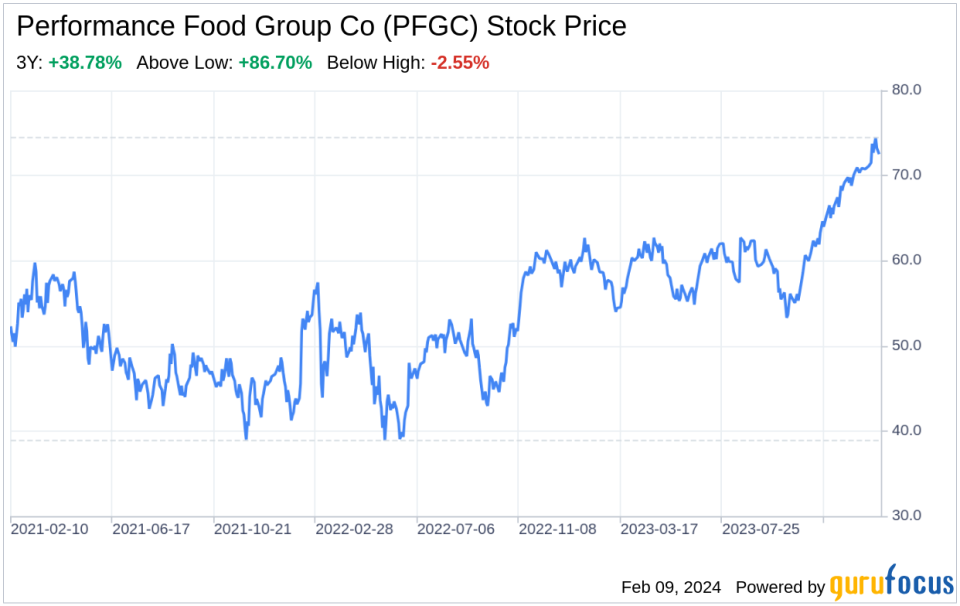Decoding Performance Food Group Co (PFGC): A Strategic SWOT Insight
Exploring PFGC's competitive edge in the food distribution industry.
Assessing the challenges and opportunities arising from economic and industry dynamics.
Understanding PFGC's strategic moves to capitalize on market trends and consumer behavior.
Anticipating the impact of external threats on PFGC's operational and financial performance.
Performance Food Group Co (NYSE:PFGC), a leading U.S. food-service distributor, recently filed its 10-Q report on February 7, 2024. This SWOT analysis delves into the company's financial health and strategic positioning, drawing insights from the latest financial data. PFGC's financial overview reveals a total lease cost of $93.7 million for the three months ended December 30, 2023, compared to $79.6 million for the same period in the previous year. Over six months, the total lease cost increased from $158.9 million to $181.4 million, indicating a significant investment in assets to bolster operations. With a market share of 9% and a diverse portfolio that includes food-service, convenience store segment, and Vistar business, PFGC is poised to leverage its strengths and navigate through potential challenges.

Strengths
Market Position and Diversification: PFGC's strong market position as the third-largest U.S. food-service distributor is a testament to its robust operational capabilities and strategic market coverage. The company's diversification across food-service, convenience store segment, and Vistar business allows it to mitigate risks associated with market fluctuations. This multi-channel approach not only enhances PFGC's resilience but also provides multiple revenue streams, contributing to a stable financial base.
Acquisition Strategy: The strategic acquisitions of Eby-Brown in 2019 and Core-Mark in 2021 have expanded PFGC's footprint in the convenience store segment, which now accounts for 41% of sales. These acquisitions have not only broadened the company's product offerings but also introduced new marketing programs and technology solutions, strengthening PFGC's competitive edge in this sector.
Proprietary and Customized Offerings: PFGC's ability to offer customized food products and services, including its Performance Brands and custom-cut meats and seafood, positions it as a value-added partner to its customers. This unique selling proposition enhances customer loyalty and differentiates PFGC from its competitors, reinforcing its market position.
Weaknesses
Reliance on Third-Party Suppliers: PFGC's dependence on external suppliers for its product range could pose risks in the event of supply chain disruptions. This reliance makes the company vulnerable to supplier-related issues, such as price volatility and availability, which could impact PFGC's ability to meet customer demands consistently.
Low Margin Industry: Operating in a low margin industry, PFGC faces the challenge of maintaining profitability amidst intense competition. The volatility of results due to cost inflation, deflation, and other factors requires PFGC to continuously optimize its cost structure to sustain its financial health.
Labor and Technology Risks: The company's need for qualified labor and reliance on technology for operations exposes it to risks associated with labor shortages and potential cybersecurity incidents. These factors could lead to increased operational costs and disruptions, affecting PFGC's efficiency and profitability.
Opportunities
Expanding Consumer Base: Changes in consumer eating habits and the increasing trend of food-away-from-home spending present growth opportunities for PFGC. By capitalizing on these trends, PFGC can expand its customer base, particularly in the independent and chain restaurant sectors, as well as in institutional settings.
Operational Efficiency: PFGC's ongoing efforts in operational cost reduction and productivity improvement have the potential to enhance its profitability. By leveraging new technologies and optimizing its supply chain, PFGC can achieve greater efficiency and cost savings, translating into competitive pricing and improved margins.
Environmental and Health Trends: The growing consumer focus on health and sustainability offers PFGC the chance to innovate its product offerings. By incorporating eco-friendly practices and healthier food options, PFGC can attract a broader customer demographic and establish itself as a forward-thinking industry leader.
Threats
Economic and Market Volatility: PFGC operates in an environment susceptible to economic downturns and shifts in consumer confidence. Factors such as inflation, public health crises, and adverse changes in discretionary spending can negatively impact the company's sales and profitability.
Intense Competition: The food distribution industry is highly competitive, with PFGC facing pressure from larger players like Sysco and US Foods. To remain competitive, PFGC must continuously innovate and adapt to market demands while managing its cost structure effectively.
Regulatory and Legal Risks: PFGC is subject to a myriad of regulations, including those related to food safety, environmental laws, and taxation. Compliance with these regulations incurs costs, and any failure to adhere could result in fines, legal proceedings, and reputational damage.
In conclusion, Performance Food Group Co (NYSE:PFGC) exhibits a strong market presence with opportunities for growth through strategic acquisitions and diversified offerings. However, the company must navigate the challenges of a low margin industry, reliance on third-party suppliers, and intense competition. By focusing on operational efficiencies and adapting to changing consumer preferences, PFGC can leverage its strengths to capitalize on market opportunities while mitigating the risks posed by economic volatility and regulatory pressures.
This article, generated by GuruFocus, is designed to provide general insights and is not tailored financial advice. Our commentary is rooted in historical data and analyst projections, utilizing an impartial methodology, and is not intended to serve as specific investment guidance. It does not formulate a recommendation to purchase or divest any stock and does not consider individual investment objectives or financial circumstances. Our objective is to deliver long-term, fundamental data-driven analysis. Be aware that our analysis might not incorporate the most recent, price-sensitive company announcements or qualitative information. GuruFocus holds no position in the stocks mentioned herein.
This article first appeared on GuruFocus.
